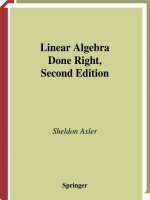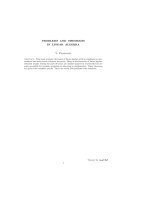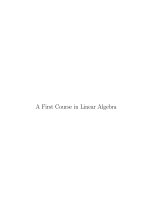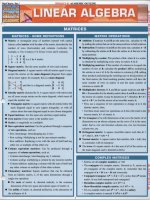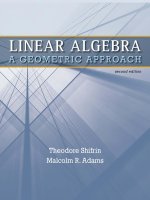Steven a leduc linear algebra (cliffs quick review) cliffs notes (1996)
Bạn đang xem bản rút gọn của tài liệu. Xem và tải ngay bản đầy đủ của tài liệu tại đây (27.63 MB, 327 trang )
www.pdfgrip.com
Cliffs Quick Revie w
Linear
Algebra
by
Steven A . Leduc
Series Edito r
Jerry Bobrow, Ph .D .
Wiley Publishing, Inc .
www.pdfgrip.com
www.pdfgrip.com
Cliffs Quick Revie w
Linear
Algebra
by
Steven A . Leduc
Series Edito r
Jerry Bobrow, Ph .D .
Wiley Publishing, Inc .
www.pdfgrip.com
CliffsNotes TM Linear Algebra
Published by:
Wiley Publishing, Inc.
909 Third Avenu e
New York, NY 1002 2
www.wiley.com
Note : If you purchased this book without a cover ,
you should be aware that this book is stolen prop erty. It was reported as "unsold and destroye d " to
the publisher, and neither the author nor the publisher has received any payment for this "stripped
book ."
Copyright © 1996 Wiley Publishing, Inc ., New York, New York
ISBN : 0-8220-5331-4
Printed in the United States of Americ a
1098765 4
1 O/SV/QW/QS/I N
Published by Wiley Publishing, Inc ., New York, NY
Published simultaneously in Canad a
No part of this publication may be reproduced, stored in a retrieval system, or transmitted in any form or by any
means, electronic, mechanical, photocopying, recording, scanning, or otherwise, except as permitted under Section s
107 or 108 of the 1976 United States Copyright Act, without either the prior written permission of the Publisher, o r
authorization through payment of the appropriate per-copy fee to the Copyright Clearance Center, 222 Rosewoo d
Drive, Danvers, MA 01923, 978-750-8400, fax 978-750-4744 . Requests to the Publisher for permission should b e
addressed to the Legal Department, Wiley Publishing, Inc ., 10475 Crosspoint Blvd., Indianapolis, IN 46256 ,
317-572-3447, fax 317-572-4447, or e-mail permcoordinator@wiley . corn
LIMIT OF LIABILITY/DISCLAIMER OF WARRANTY : THE PUBLISHER AND AUTHOR HAVE USE D
THEIR BEST EFFORTS IN PREPARING THIS BOOK . THE PUBLISHER AND AUTHOR MAKE NO REPRESENTATIONS OR WARRANTIES WITH RESPECT TO THE ACCURACY OR COMPLETENESS OF TH E
CONTENTS OF THIS BOOK AND SPECIFICALLY DISCLAIM ANY IMPLIED WARRANTIES OF MERCHANTABILITY OR FITNESS FOR A PARTICULAR PURPOSE . THERE ARE NO WARRANTIES WHICH
EXTEND BEYOND THE DESCRIPTIONS CONTAINED IN THIS PARAGRAPH . NO WARRANTY MAY B E
CREATED OR EXTENDED BY SALES REPRESENTATIVES OR WRITTEN SALES MATERIALS . THE ACCURACY AND COMPLETENESS OF THE INFORMATION PROVIDED HEREIN AND THE OPINION S
STATED HEREIN ARE NOT GUARANTEED OR WARRANTED TO PRODUCE ANY PARTICULA R
RESULTS, AND THE ADVICE AND STRATEGIES CONTAINED HEREIN MAY NOT BE SUITABLE FO R
EVERY INDIVIDUAL. NEITHER THE PUBLISHER NOR AUTHOR SHALL BE LIABLE FOR ANY LOSS O F
PROFIT OR ANY OTHER COMMERCIAL DAMAGES, INCLUDING BUT NOT LIMITED TO SPECIAL ,
INCIDENTAL, CONSEQUENTIAL, OR OTHER DAMAGES. FULFILLMENT OF EACH COUPON OFFER
IS THE RESPONSIBILITY OF THE OFFEROR.
Trademarks : Wiley, the Wiley Publishing logo, Cliffs, CliffsNotes, the CliffsNotes logo, CliffsAP, CliffsComplete ,
CliffsTestPrep, CliffsQuickReview, CliffsNote-a-Day and all related logos and trade dress are registered trademarks o r
trademarks of Wiley Publishing, Inc ., in the United States and other countries . All other trademarks are property o f
their respective owners . Wiley Publishing, Inc ., is not associated with any product or vendor mentioned in this book .
For general information on our other products and services or to obtain technical support, please contact our Custome r
Care Department within the U.S . at 800-762-2974, outside the U .S . at 317-572-3993, or fax 317-572-4002 .
Wiley also publishes its books in a variety of electronic formats . Some content that appears in print may not be avail able in electronic books.
www.pdfgrip.com
VECTOR A►LGEBRA
1
The Space R2
Vectors in R2
Position vectors
Vector addition
Vector subtraction
Scalar multiplication
Standard basis vectors in R2
The Space R 3
Standard basis vectors in R3
The cross product
The Space R"
The norm of a vector
Distance between two points
Unit vectors
The dot product
The triangle inequality
The Cauchy-Schwarz inequality
Orthogonal projections
Lines
Planes
1
3
7
8
11
12
13
16
17
19
22
23
25
26
27
31
32
36
39
43
's
47
MA
A►I~GEBItA
Matrices
Entries along the diagonal
Square matrices
Triangular matrices
The transpose of a matrix
Row an column matrices
Zero matrices
Operations with Matrices
Matrix addition
LINEAR ALGEBRA
47
49
50
50
51
52
53
53
53
www.pdfgrip.com
CONTENTS
Scalar multiplication
Matrix multiplication
Identity matrices
The inverse of a matrix
56
57
70
76
LINEAR SYSTEMS
Solutions to Linear Systems
Gaussian Elimination
Gauss-Jordan Elimination
Using Elementary Row Operations to Determine K 1
85
85
90
96
109
REAL EUCLIDEAN VECTOR SPACES
Subspaces of Rn
The Nullspace of a Matrix
Linear Combinations and the
Span of a Collection of Vectors
Linear Independence
The Rank of a Matrix
A Basis for a Vector Space
Orthonormal bases
Projection onto a Subspace
The Gram-Schmidt orthogonalization algorithm
The Row Space and Column Space of a Matrix
Criteria for membership in the column space
The Rank Plus Nullity Theorem
Other Real Euclidean Vector Space s
and the Concept of Isomorphism
Matrix spaces
Polynomial spaces
Function spaces
123
12 3
13 0
iv
134
137
145
150
157
160
16 7
17 6
17 7
18 3
18 9
18 9
19 2
194
CLIFFS QUICK REVIE W
www.pdfgrip.com
CONTENTS
THE DETE
ANT
Definitions of the Determinant
Method 1 for defining the determinant
Method 2 for defining the determinant
Laplace Expansions for the Determinant
Laplace expansions following row-reduction
Cramer's Rule
The Classical Adjoint of a Square Matrix
LINEAR TRANSFORMATIONS
Definition of a Linear Transformation
Linear Transformations and Basis Vectors
The Standard Matrix of a Linear Transformation
The Kernel and Range of a Linear Transformation
Injectivity and surj ectivity
Composition of Linear Transformations
197
19 7
19 7
20 6
220
23 4
23 6
24 1
251
25 1
260
263
27 2
28 0
28 5
EIGENVALUES AND EIGENVECTORS
293
Definition and Illustration o f
an Eigenvalue and an Eigenvector
Determining the Eigenvalues of a Matrix
Determining the Eigenvectors of a Matrix
Eigenspaces
Diagonalization
29 3
29 4
29 8
30 7
31 1
LINEAR ALGEBRA
v
www.pdfgrip.com
www.pdfgrip.com
VECTOR ALGEBRA
It is assumed that at this point in your mathematical education, you are familiar with the basic arithmetic operations an d
algebraic properties of the real numbers, the set of which i s
denoted R . Since the set of reals has a familiar geometric depiction, the number line, R is also referred to as the real lin e
and alternatively denoted R ' ("R one") .
The Space R2
Algebraically, the familiar x -y plane is simply the collection of
all pairs (x, y) of real numbers. Each such pair specifies a
point in the plane as follows . First, construct two copies of the
real line—one horizontal and one vertical which intersect
perpendicularly at their origins ; these are called the axes .
Then, given a pair (xl , x2), the first coordinate, x l , specifies th e
point's horizontal displacement from the vertical axis, whil e
the second coordinate, x2, gives the vertical displacement fro m
the horizontal axis . See Figure 1 . Clearly, then, the order i n
which the coordinates are written is important since the point
(x l , x2) will not coincide generally with the point (x2, xl) .
To emphasize this fact, the plane is said to be the collection o f
ordered pairs of real numbers . Since it takes two real number s
to specify a point in the plane, the collection of ordered pair s
(or the plane) is called 2-space, denoted R 2 ("R two") .
LINEAR ALGEBRA
1
www.pdfgrip.com
VECTOR
ALGEBRA
;
(XI , X2 )
x2
xl
■ Figure 1
■
R2 is given an algebraic structure by defining two operation s
on its points . These operations are addition and scalar multiplication . The sum of two points x = (xl , xZ ) and x' = (x;, xZ )
is defined (quite naturally) by the equation
x+x' =(x l , x Z) + (x i, x2) = (xl +x i, xZ +x2 )
and a point x = (xl , x2 ) is multiplied by a scalar c (that is, by
a real number) by the rule
cx = c(xl , x2) = (cx1, cx2 )
Example 1 : Let x = (1, 3) and y = (—2, 5) . Determine th e
points x + y, 3x, and 2x — y .
The point x + y is (1, 3) + (—2, 5) = (—1, 8), and the poin t
3x equals 3(1, 3) = (3, 9) . Since —y = (—1)y = (2, -5) ,
2x—y=2x+(—y) = 2(1, 3) + (2, -5 )
= (2, 6) + (2, -5) = (4, 1 )
CLIFFS QUICK REVIEW
2
www.pdfgrip.com
VECTOR
ALGEBRA
By defining x — x' to be x + (—x'), the difference of tw o
points can be given directly by the equatio n
x - x' _
( .710
1 x2 ) - (x;,
,
JICZ)
_
(xi -
7Ci ,
x2
- JIC2 )
Thus, the point 2x — y could also have been calculated as follows :
2x—y = 2(1, 3)—(—2, 5) = (2, 6)—(—2, 5 )
= (2 — (—2), 6 — 5) = (4, 1)
111
Vectors in R 2. A geometric vector is a directed line segment
from an initial point (the tail) to a terminal or endpoint (th e
tip) . It is pictured as an arrow as in Figure 2 .
endpoint
("tip" )
initial point
("tail")
■ Figure 2
■
The vector from point a to point b is denoted ab . If a = (a l ,
a2) is the initial point and b = (b 1 , b2) is the terminal point ,
then the signed numbers b 1 — a1 and b2 — a2 are called th e
components of the vector ab . The first component, b 1 — a l ,
indicates the horizontal displacement from a to b, and the second component, b2 — a2, indicates the vertical displacement .
See Figure 3. The components are enclosed in parentheses t o
specify the vector ; thus, ab = ( b 1 — al, b2 — a2) .
LINEAR ALGEBRA
3
www.pdfgrip.com
VECTOR
ALGEBRA
■ Figure 3
■
Example 2 : If a = (4, 2) and b = (—5, 6), then the vector from
a to b has a horizontal component of -5 — 4 = -9 and a vertical component of 6 — 2 = 4 . Therefore, ab = (—9, 4), which i s
sketched in Figure 4 .
b=(—5,6)
ab = (—I, 4 )
4
-9
a=(4,2 )
■ Figure 4 ■
4
CLIFFS QUICK REVIE W
www.pdfgrip.com
VECTO R
ALGEBRA
Example 3 : Find the terminal point of the vector xy = (8, -7 )
if its initial point is x = (—3, 5) .
Since the first component of the vector is 8, adding 8 t o
the first coordinate of its initial point will give the first coordinate of its terminal point . Thus, y l = x i + 8 = -3 + 8 = 5 .
Similarly, since the second component of the vector is -7 ,
adding -7 to the second coordinate of its initial point will giv e
the second coordinate of its endpoint . This gives y 2 = xZ +
(—7) = 5 + (—'7) = -2 . The terminal point of the vector xy i s
therefore y = (y,, y2) = (5, -2) ; see Figure 5 .
x=(—3,5)
xy = (8, 7)
8
Y=
Y2 )
= (x 1 + 8, x 2 — 7)
=(—3+8, 5—7 )
= ( 5, — 2 )
■ Figure 5 ■
Two vectors in R2 are said to be equivalent (or equal) i f
they have the same first component and the same secon d
component . For instance, consider the points a = (—1, 1), b =
(l, 4), c = (l, 2), and d = (3, 1) . The horizontal component
of the vector ab is 1 — (—1) = 2, and the vertical component o f
ab is 4 — 1 = 3 ; thus, ab = (2, 3) . Since the vector cd has a
LINEAR ALGEBRA
5
www.pdfgrip.com
VECTO R
ALGEBRA
horizontal component of 3 – 1 = 2, and a vertical componen t
of 1 – (–2) = 3, cd = (2, 3) also . Therefore, ab = cd; see Figure 6 .
b=(1,4)
a=(—1, 1)
o
d = (3, 1 )
c= (1, 2)
■ Figure 6 ■
To translate a vector means to slide it so as to change its initia l
and terminal points but not its components . If the vector ab i n
Figure 6 were translated to begin at the point c = (1, 2), it
would coincide with the vector cd. This is another way to say
that ab = cd .
Example 4 : Is the vector from a = (0, 2) to b = (3, 5) equivalent to the vector from x = (2, -4) to y = (5, 1) ?
Since the vector ab equals (3, 3), but the vector xy equals
(3, 5), these vectors are not equivalent . Alternatively, if th e
vector ab were translated to begin at the point x, its termina l
point would then be (x l + 3, x 2 + 3) = (2 + 3, -4 + 3) = (5 ,
-1) . This is not the point y ; thus, ab ~ xy . ■
CLIFFS QUICK REVIEW
6
www.pdfgrip.com
VECTOR
ALGEBRA
Position vectors . If a vector has its initial point at the origin ,
the point 0 = (0, 0), it is called a position vector . If a position
vector has x = (x 1 , x2 ) as its endpoint, then the component s
of the vector Ox are x 1 — 0 = x 1 and x 2 — 0 = x 2 ; so Ox =
(x l , x2 ). If the origin is not explicitly written, then a positio n
vector can be named by simply specifying its endpoint ; thus, x
= (x 1 , x 2 ). Note that the position vector x with components x 1
and x2 is denoted (x 1 , x 2), just like the point x with coordinates
x 1 and x2 . The context will make it clear which meaning is in tended, but often the difference is irrelevant . Furthermore ,
since a position vector can be translated to begin at any othe r
point in the plane without altering the vector (since translatio n
leaves the components unchanged), even vectors that do not
begin at the origin are named by a single letter .
Example 5 : If the position vector x = (-4, 2) is translated s o
that its new initial point is a = (3, 1), find its new termina l
point, b.
If b = (b l , b2 ), then the components of the vector ab ar e
bl — 3 and b 2 — 1 . Since ab = x ,
(b l — 3, b 2 — 1) = (—4, 2) ~ (b i, b2) = (—1, 3 )
See Figure 7.
LINEAR ALGEBRA
7
www.pdfgrip.com
VECTOR
ALGEBRA
b = (-1, 3)
x= (-`1 , 2 )
■ Figure 7
a = (3,1 )
■
Vector addition . The operations defined earlier on points (xl ,
x2) in R 2 can be recast as operations on vectors in R 2 (calle d
2-vectors, because there are 2 components) . These operations
are called vector addition and scalar multiplication . The sum
of two vectors x and x' is defined by the same rule that gave
the sum of two points :
x + x ' = (x l , x 2 ) + (x1', x2) = (xl + x;, x 2 + x2 )
Figure 8 depicts the sum of two vectors . Geometrically, one o f
the vectors (x', say) is translated so that its tail coincides with
the tip of x . The vector from the tail of x to the tip of th e
translated x' is the vector sum x + x' . This process is often
referred to as adding vectors tip-to-tail.
8
CLIFFS QUICK REVIEW
www.pdfgrip.com
VECTOR
ALGEBRA
■ Figure 8 ■
Because the addition of real numbers is commutative, that is,
because the order in which numbers are added is irrelevant, i t
follows that
(x i +
x2
+ x)
= ( x 1 + xl , x2 +x2 )
This implies the addition of vectors is commutative also :
x+x'= x' + x
Thus, when adding x and x' geometrically, it doesn't matte r
whether x' is first translated to begin at the tip of x or x i s
translated to begin at the tip of x' ; the sum will be the same i n
either case .
Example 6 : The sum of the vectors x = (1, 3) and y = (-2, 5 )
is
x + y = (1 + (-2), 3 + 5) = (-1, 8 )
See Figure 9 .
LINEAR ALGEBRA
9
www.pdfgrip.com
VECTOR
ALGEBRA
x+ Y = (1 , 8)
Y=(2,5 )
■ Figure 9 ■
Example 7 : Consider the position vector a = (1, 3) . If b is th e
point (5, 4), find the vector ab and the vector sum a + ab .
Provide a sketch .
Since ab has horizontal component 5 — 1 = 4 and vertica l
component 4 — 3 = 1, the vector ab equals (4, 1) . So a + ab =
(1, 3) + (4, 1) = (5, 4), which is the position vector b . Figure
10 clearly shows that a + ab = b .
10
CLIFFS QUICK REVIEW
www.pdfgrip.com
VECTOR
ALGEBRA
ab = (4, 1)
i
b = (5, 4)
a = (1, 3)
■ Figure 10
■
Vector subtraction . The difference of two vectors is defined
in precisely the same way as the difference of two points . For
any two vectors x and x' in R2,
x — x' _ (xl , x2 ) — (x;, x2) _ (x1 — x;, x 2 — x2 )
With x and x' starting from the same point, x — x' is the vector that begins at the tip of x' and ends at the tip of x . Thi s
observation follows from the identity x' + (x — x') = x and the
method of adding vectors geometrically . See Figure 11 .
■ Figure 11
LINEAR ALGEBRA
■
11
www.pdfgrip.com
VECTOR
ALGEBRA
In general, it is easy to see tha t
ab = b — a
whether the letters on the right-hand side are interpreted a s
position vectors or as points . Figure 10 showed that a + ab =
b, which is equivalent to the statement ab = b — a, where a and
b are position vectors . Although this example dealt with a particular case, the identity ab = b — a holds in general .
Example 8 : The vector ab from a = (4, -1) to b = (—2, 1) i n
Figure 12 i s
ab=b—a=(—2, 1)—(4,—1)=(2—4, 1 +1)=(-6,2 )
,
■ Figure 12 ■
Scalar multiplication. A vector x is multiplied by a scalar c b y
the rule
cx = c(xI, x2 ) = (cxI, cx2 )
12
CLIFFS QUICK REVIEW
www.pdfgrip.com
VECTO R
ALGEBR A
If the scalar c is 0, then for any x, cx equals (0, 0)—the zero
vector, denoted 0. If c is positive, the vector cx points in th e
same direction as x, and it can be shown that its length is c
times the length of x . However, if the scalar c is negative, the n
cx points in the direction exactly opposite to that of the original x, and the length of cx is Id times the length of x . Some
examples are shown in Figure 13 :
■ Figure 13
■
Two vectors are said to be parallel if one is a positive scala r
multiple of the other and antiparallel if one is a negative scalar multiple of the other . (Note : Some authors declare two
vectors parallel if one is a scalar multiplepositive or negative—of the other.)
Standard basis vectors in R 2. By invoking the definitions o f
vector addition and scalar multiplication, any vector x = (x, ,
x2) in R2 can be written in terms of the standard basis vector s
LINEAR ALGEBRA
13
www.pdfgrip.com
VECTOR
ALGEBRA
(1, 0) and (0, 1) :
(x,, x2 )=(x„ 0)+(0, x2 )=x, (l, 0)+x2 (0, 1 )
The vector (1, 0) is denoted by i (or e,), and the vector (0, 1 )
is denoted by j (or e 2). Using this notation, any vector x in R2
can be written in either of the two form s
x = x l i +x2j or x = x l el + x2 e2
See Figure 14 .
j'
xli
x=x1i+x 2j
■ Figure 14 ■
Example 9 : If x = 2i + 4j and y = i — 3j, determine (and pro vide a sketch of) the vectors x and x + y .
Multiplying the vector x by the scalar
2
yields
x= (2i+4j) = ( . 2)i+(. .
The sum of the vectors x and y is
14
CLIFFS QUICK REVIEW
www.pdfgrip.com
VECTO R
ALGEBR A
x + y = (2i + 4j) + (i — 3j) _ (2 + 1)i + (4 — 3)j = 3i + j
These vectors are shown (together with x and y) in Figure 15 .
x=2i+4j
y=i—3j
2x=i+2j
x+y=3i+ j
Sr
= I - 3j
■ Figure 15
■
Example 10 : Find the scalar coefficients k, and k2 such that
k,(1, -3) + k2(—1, 2) = (—1, -2 )
The given equation can be rewritten as follows :
(lc, — k2 , -3k l + 2k2) = (—1, -2)
This implies that both of the following equations must be satisfied :
-3k1 + 2k2 = -2
(* )
Multiplying the first equation by 3 then adding the result t o
the second equation yields
LINEAR ALGEBRA
15
www.pdfgrip.com
VECTO R
ALGEBRA
Ski — 3k2
= -3
+2k2 =—2
—k2
= -5
Thus, k2 = 5 . Substituting this result back into either of th e
equations in (*) gives kl = 4 . ■
The Space R3
mutually perpendicular copies of the real line intersec t
at their origins, any point in the resulting space is specified b y
an ordered triple of real numbers (x 1 , x2 , x3). The set of al l
ordered triples of real numbers is called 3-space, denoted R 3
("R three") . See Figure 16 .
If three
■ Figure 16 ■
The operations of addition and scalar multiplication define d
on R2 carry over to R3:
16
CLIFFS QUICK REVIEW

